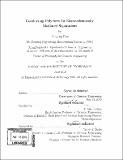Conducting polymers for electrochemically mediated separations
Author(s)
Ren, Yinying.
Download1418761050-MIT.pdf (14.52Mb)
Other Contributors
Massachusetts Institute of Technology. Department of Chemical Engineering.
Terms of use
Metadata
Show full item recordAbstract
Many conventional separation technologies are limited by high energy costs, generation of chemical wastes, and lack of molecular selectivity. This thesis is motivated to develop novel separation techniques that overcome the aforementioned drawbacks for the separation of neutral organic compounds from aqueous solutions. Adsorption is one of the most widely adopted technologies for the intended task. Polymeric adsorbents have shown great potential for replacing activated carbon for removing a wide range of toxic organic pollutants from wastewater streams since they do not suffer from costly regeneration needs and high attrition rates. An electrochemically regenerable polymeric adsorbent based on an intrinsically conducting polymer, polypyrrole (PPy), doped with anionic surfactant dioctylsulfosuccinate (AOT), denoted PPy(AOT), is developed for mitigating organic pollutants in wastewater. Highly porous PPy(AOT) can be synthesized using a facile electropolymerization protocol, and has an adsorption capacity of greater than 570 mg pollutant/g polymer in its superhydrophobic oxidized state. The hydrophobicity of PPy(AOT) and hence its affinity for organics can be modulated electrochemically through the reorientation of AOT dopants, which can be exploited to regenerate the adsorbent and use it repeatedly for multiple adsorption/desorption cycles. A combined density functional theory and molecular dynamics approach was used to study the interactions between the adsorbed organic molecules and the surfactant-doped conducting polymer adsorbent, and to elucidate the mechanism of electrochemical modulations of hydrophobicity and affinity of the sorbent. The AOT doped polypyrrole (PPy(AOT)) and a polyvinylferrocene/polypyrrole hybrid (PVF-PPy) have complementary hydrophobicity tunability in response to electrochemical modulations: both materials are hydrophobic in their respective neutral states, exhibiting high affinities towards organics; upon application of a mild potential to oxidize PVF-PPy and reduce PPy(AOT), they can be simultaneously rendered hydrophilic, thereby driving desorption of organics and regeneration of the materials. Therefore, the two materials form an attractive pair for an asymmetric electrode system to work in tandem. The asymmetric system can be used in a cyclic fashion, through repeated application of a small potential (close to 0 V) to program the capture of organics from a large volume of feed solution, and a higher potential (above 0.9 V) to stimulate the release of the adsorbed organics into a small volume of desorption solution. The redox-responsive electrode system can be applied for remediation of organic pollution in wastewater as well as recovery of organic products from reaction mixtures. The asymmetric configuration has multiple benefits, including suppression of water parasitic reactions, high energetic efficiency, and selectivity for target organic species. The ability to modulate the hydrophobicity of conducting polymers and physicochemical insights about the material are significant for developing broader applications in drug delivery, sensing, self-cleaning surfaces, microfluidics, and artificial muscles.
Description
Thesis: Ph. D., Massachusetts Institute of Technology, Department of Chemical Engineering, 2019 Cataloged from the official PDF of thesis. Includes bibliographical references (pages 123-134).
Date issued
2019Department
Massachusetts Institute of Technology. Department of Chemical EngineeringPublisher
Massachusetts Institute of Technology
Keywords
Chemical Engineering.